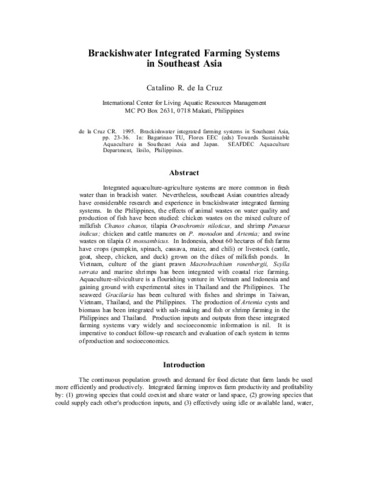Culture experiments on the copepod, Tisbintra elongata MORI, and evaluation of that species as food organism for milkfish larvae
- Global styles
- MLA
- Vancouver
- Elsevier - Harvard
- APA
- Help
Share
抄録
Five types of food were used to culture T. elongata: rice bran, cow dung, bread, cow dung, bread yeast, fermented fish solubles and Spirulina. Bread yeast was found to give the highest densities. An evaluation was also made of the effectivity of rice bran and fermented fish solubles for the outdoor mass culture of T. elongata . A comparative study on the growth and survival rate of milkfish fry (Chanos chanos) fed with T. elongata and Artemia showed there to be no significant differences between the diets.
Suggested Citation
Yamasaki, S., & Canto Jr., J. (1979). Culture experiments on the copepod, Tisbintra elongata MORI, and evaluation of that species as food organism for milkfish larvae. SEAFDEC Aquaculture Department Quarterly Research Report , 3(4), 17-20. http://hdl.handle.net/10862/2359
Type
ArticleCollections
Related items
Showing items related by title, author, creator and subject.
-
Aquaculture in the Philippines
Aypa, Simeona M. (Aquaculture Department, Southeast Asian Fisheries Development Center, 1995)Aquaculture is regarded as the most promising source of protein food in the years ahead. Milkfish and Nile tilapia are the major fishes now produced but groupers, sea bass, rabbitfish, red snappers, carps, and catfishes ... -
Management of feeding aquaculture species
Alava, Veronica R. (Aquaculture Department, Southeast Asian Fisheries Development Center, 2002)This chapter teaches the reader to: differentiate the different feeding strategies in pond culture; learn feeding management methods such as stock sampling and record keeping, calculating daily feed ration, choosing ... -
Brackishwater integrated farming systems in Southeast Asia
De la Cruz, Catalino R. (Aquaculture Department, Southeast Asian Fisheries Development Center, 1995)Integrated aquaculture-agriculture systems are more common in fresh water than in brackish water. Nevertheless, southeast Asian countries already have considerable research and experience in brackishwater integrated farming ...







